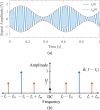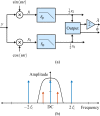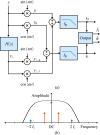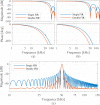A review of demodulation techniques for amplitude-modulation atomic force microscopy
- PMID: 28900596
- PMCID: PMC5530615
- DOI: 10.3762/bjnano.8.142
A review of demodulation techniques for amplitude-modulation atomic force microscopy
Abstract
In this review paper, traditional and novel demodulation methods applicable to amplitude-modulation atomic force microscopy are implemented on a widely used digital processing system. As a crucial bandwidth-limiting component in the z-axis feedback loop of an atomic force microscope, the purpose of the demodulator is to obtain estimates of amplitude and phase of the cantilever deflection signal in the presence of sensor noise or additional distinct frequency components. Specifically for modern multifrequency techniques, where higher harmonic and/or higher eigenmode contributions are present in the oscillation signal, the fidelity of the estimates obtained from some demodulation techniques is not guaranteed. To enable a rigorous comparison, the performance metrics tracking bandwidth, implementation complexity and sensitivity to other frequency components are experimentally evaluated for each method. Finally, the significance of an adequate demodulator bandwidth is highlighted during high-speed tapping-mode atomic force microscopy experiments in constant-height mode.
Keywords: amplitude estimation; amplitude modulation; atomic force microscopy; digital signal processing; field-programmable gate array.
Figures










 , the frequency response of the interpolation filter can be neglected.
, the frequency response of the interpolation filter can be neglected.












Similar articles
-
A review of demodulation techniques for multifrequency atomic force microscopy.Beilstein J Nanotechnol. 2020 Jan 7;11:76-91. doi: 10.3762/bjnano.11.8. eCollection 2020. Beilstein J Nanotechnol. 2020. PMID: 31976199 Free PMC article. Review.
-
Lyapunov estimation for high-speed demodulation in multifrequency atomic force microscopy.Beilstein J Nanotechnol. 2018 Feb 8;9:490-498. doi: 10.3762/bjnano.9.47. eCollection 2018. Beilstein J Nanotechnol. 2018. PMID: 29515961 Free PMC article.
-
A novel phase-shift-based amplitude detector for a high-speed atomic force microscope.Rev Sci Instrum. 2018 Aug;89(8):083704. doi: 10.1063/1.5038095. Rev Sci Instrum. 2018. PMID: 30184715
-
A constant-frequency feedback loop for non-contact frequency-modulated atomic force microscopy via root locus: Implemented on a single-board field-programmable gate array device.Rev Sci Instrum. 2020 Nov 1;91(11):113702. doi: 10.1063/5.0023144. Rev Sci Instrum. 2020. PMID: 33261448
-
Control of the higher eigenmodes of a microcantilever: applications in atomic force microscopy.Ultramicroscopy. 2014 Feb;137:66-71. doi: 10.1016/j.ultramic.2013.11.011. Epub 2013 Dec 10. Ultramicroscopy. 2014. PMID: 24361530
Cited by
-
Editorial for the Special Issue on Electronics for Sensors II.Sensors (Basel). 2023 Feb 2;23(3):1640. doi: 10.3390/s23031640. Sensors (Basel). 2023. PMID: 36772679 Free PMC article.
-
Gradient Estimator-Based Amplitude Estimation for Dynamic Mode Atomic Force Microscopy: Small-Signal Modeling and Tuning.Sensors (Basel). 2020 May 9;20(9):2703. doi: 10.3390/s20092703. Sensors (Basel). 2020. PMID: 32397441 Free PMC article.
-
Unraveling Spatiotemporal Transient Dynamics at the Nanoscale via Wavelet Transform-Based Kelvin Probe Force Microscopy.ACS Nano. 2023 Nov 14;17(21):21506-21517. doi: 10.1021/acsnano.3c06488. Epub 2023 Oct 25. ACS Nano. 2023. PMID: 37877266 Free PMC article.
-
Accurate Signal Conditioning for Pulsed-Current Synchronous Measurements.Sensors (Basel). 2022 Jul 18;22(14):5360. doi: 10.3390/s22145360. Sensors (Basel). 2022. PMID: 35891039 Free PMC article.
-
A review of demodulation techniques for multifrequency atomic force microscopy.Beilstein J Nanotechnol. 2020 Jan 7;11:76-91. doi: 10.3762/bjnano.11.8. eCollection 2020. Beilstein J Nanotechnol. 2020. PMID: 31976199 Free PMC article. Review.
References
-
- Haykin S. Communication systems. John Wiley & Sons; 2008.
-
- Nyce D S. Linear position sensors: theory and application. John Wiley & Sons; 2004.
-
- Baxter L K. Capacitive sensors: Design and Applications. Wiley-IEEE Press; 1996.
-
- Fleming A J. Sens Actuators, A. 2013;190:106–126. doi: 10.1016/j.sna.2012.10.016. - DOI
-
- Tsui D C, Stormer H L, Gossard A C. Phys Rev Lett. 1982;48:1559–1562. doi: 10.1103/PhysRevLett.48.1559. - DOI
Publication types
LinkOut - more resources
Full Text Sources
Other Literature Sources
Research Materials
